|
![]() One Good Occultation Deserves Another
One Good Occultation Deserves Another
7.03.2005 | Lunnoe foto dnya
John Robinson and Arthur Coombs, the hard-observing duo who are the only people to have imaged all the Lunar 100, made this great record of the Feb 27 occultation of Jupiter by the Moon.
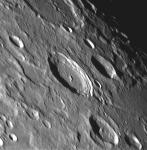 A Single Twin
A Single Twin
6.03.2005 | Lunnoe foto dnya
Did you know that the diameter of Geminus is one kilometer larger than Tycho? 86 vs 85 km. Tycho is one of the best studied lunar craters because it is relatively large, but more importantly it is young (about 100 m.y.) and has the largest ray system on the Moon.
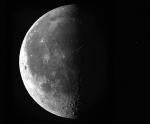 Before and After: Antares and the Moon
Before and After: Antares and the Moon
5.03.2005 | Lunnoe foto dnya
John writes, I took this image of the lunar occultation of Antares Wednesday morning practically in daylight. It is a 2 image composite of both the disappearance and reappearance of the bright star Antares (Alpha Scorpii). Clouds moved in just before disappearance, but cleared again and I was able to actually watch the reappearance.
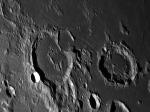 Go See 'Em - They are Gut
Go See 'Em - They are Gut
4.03.2005 | Lunnoe foto dnya
The Moon is full of hinterlands - places that are aren’t near famous craters, and hence are often overlooked. The western shore of Mare Fecunditatis is almost all hinterland – it is possible that no ever notices it because of the great attractions luring observers east (Messier twins) and west (Theophilus and neighbors).
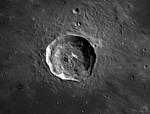 Rare Image of Common Crater
Rare Image of Common Crater
3.03.2005 | Lunnoe foto dnya
There are about 600 named craters on the lunar nearside, but I would guess that contributors have sent LPOD good images of at most about 10% of them. Everyone knows the superstar craters that get almost all of an observer’s attention, but the more humdrum craters have stories to tell us too.
![]() LPOD Image of the Month: February, 2005
LPOD Image of the Month: February, 2005
2.03.2005 | Lunnoe foto dnya
Congratulations to Paolo for the First LPOD of the Month for 2005! And thanks to the folks who voted for 8 different daily images! I can never get too much of Orientale. True...
 A Close Approach
A Close Approach
1.03.2005 | Lunnoe foto dnya
The fact that the Moon makes close approaches to the planets demonstrates one of the important regularities of our solar system. The planets orbit within a relatively flat ecliptic plane and the Moon, orbiting near the Earth’s equatorial plane, bobs around the ecliptic.
 A Fractured Plateau
A Fractured Plateau
28.02.2005 | Lunnoe foto dnya
The Aristarchus Plateau is trapezoid of mystery - an island of roughness and uniqueness in northern Oceanus Procellarum. Try to ignore the unrelated addition of gaudy Aristarchus and its wreath of ejecta that obscures the Plateau’s southeastern end. Just look at the structure of the Plateau.
 One Crater’s Nomenclature
One Crater’s Nomenclature
27.02.2005 | Lunnoe foto dnya
Lunar nomenclature is such a trivial bugaboo. It is trivial in the sense that it has no physical reality and it is much less interesting than the craters, rilles, mountains it denotes. But clear, well defined nomenclature is essential if you want to efficiently communicate anything about those features.
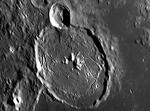 A Warhorse, Again
A Warhorse, Again
26.02.2005 | Lunnoe foto dnya
At classical music radio stations (a dying breed), program directors refer to The 1812 Overture, Beethoven’s 9th symphony, Capriccio Italian, and similar popular classics as warhorses. These very well known compositions are guaranteed crowd pleasers, but playing them reduces opportunities to hear other interesting, but less famous music.

